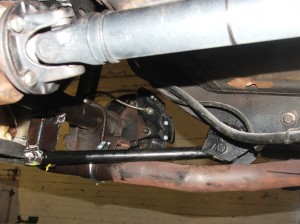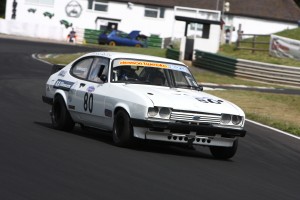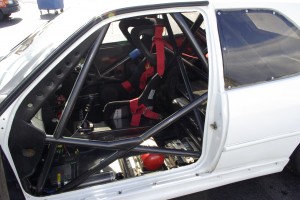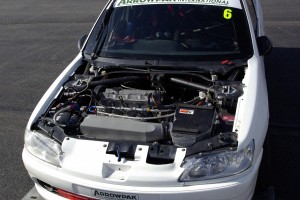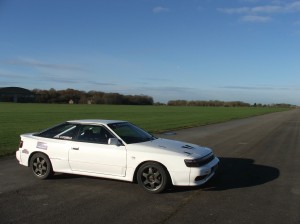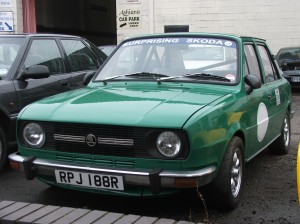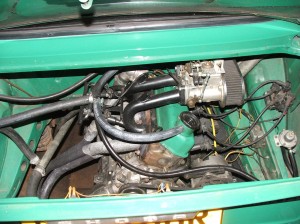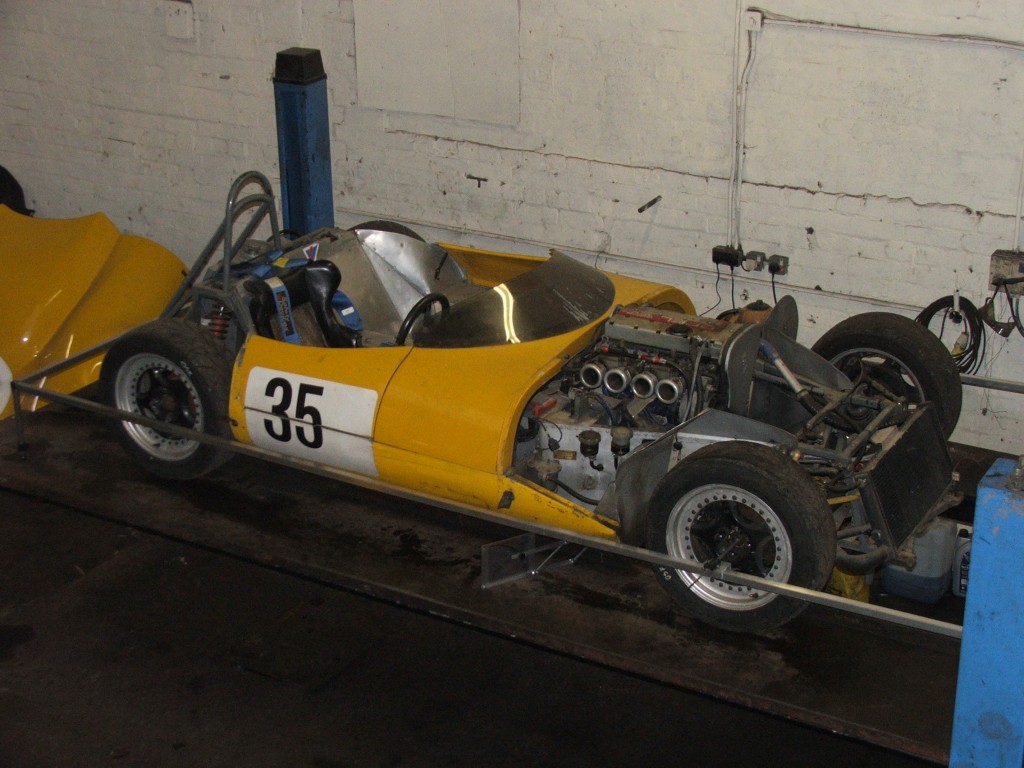The AA Sport/AA Silencers Capri race car continues to be developed in between other commitments. The latest development is with the rear axle location. These bars reduce both axle tramp and lateral movement. An added advantage is that by moving the pickup points we’ve been able to change the roll axis of the car and hopefully improve the handling. More testing is required but it looks good so far
Posts Tagged ‘4 wheel alignment’
Capri Development
Tuesday, August 14th, 2012It’s what we do- excerpt from an article for Practical Performance Car magazine
Friday, April 27th, 2012It’s strange that the first question people ask when they’re checking out modified cars is often ‘How much power has it got?’ It’s all well and good being able to say it’s got 400 bhp, but how much weight is that power having to shift? If the car weighs two tonnes then you’ve only got 200 bhp per tonne, which is suddenly less impressive. That’s only equal to a 100 bhp engine in a 500 kg car. The thing is if you tell people you’ve only got 100 bhp they’ll snigger and walk away. ‘Pfff, my Mom’s Corsa has got more power than that’. The conversation’s over before anyone mentions weight.
Weight goes far beyond the simple bhp/tonne figure though. Bigger engines will often produce more than enough power to compensate for their extra weight. Carrying a hoofing great engine around does nothing for the handling though. The overall weight of a car will make a huge difference to how it accelerates, brakes and turns into a corner. The distribution of the weight in the car is just as important and can be used to either tune or ruin the handling characteristics.
It’s fairly obvious that having a light car means you can accelerate and brake faster, there’s less weight to move around. But just as important is how the weight is spread out across the cars tyres. Each tyre is actually holding up a different weight. In most road cars with the engine up front, the front tyres are holding up a lot more weight than the rears. Likewise with only the driver in, the off side tyres are carrying more weight than the nearside. Amongst other things, the amount of weight (or down force) a tyre has on it will dictate how much grip it can produce, up to a point. From that you could think a heavier car could corner faster. The problem is that the cars weight also acts sideways in a corner and it takes some of the available grip of the tyre and pulls it sideways, causing the tyre to ‘scrub‘. All tyres scrub sideways when turning, it’s known as the slip angle. Push the slip angle too far and you’re sliding, push the slide too far and you’re spinning. Heavier cars increase slip angles faster than light ones so they run out of grip faster.
To help ensure each tyre is carrying an equal load to start with, cars can be corner weighted. That involves raising the spring heights so more load goes onto the corners where there was less. Unless you have a very well balanced car the weight distribution will always be biased in one direction or another, but it helps to spread the cars weight as evenly as possible. This means each tyre is doing it’s fair share of clinging your car to the road. Corner weighting a car doesn’t necessarily move the weight distribution in the car, it just alters how the car’s suspension supports it.
Of course all that talk of spreading the weight out on the tyres is massively over simplified. There’s so many other factors influencing how the car’s suspension behaves, and all we’ve considered so far is how the weight is supported across the four corners. We should also spare a thought for where the weight is in the car. Rather than just say the car has weight, the weight distribution around the car can all be added up and said to have a centre of gravity. It’s basically the balance point for all the weight in the car. If the car was hung from a rope attached at the centre of gravity it would always be balanced. The centre of gravity also has a height within the car. The higher the centre of gravity the more a car will lean as it corners. It leans, or rolls because opposing forces act on the centre of gravity as you corner. It’s those forces you can feel when you are pushed out of your seat as the car brakes or corners. This is called weight transfer. The more it rolls during a corner the more it takes load off the inside tyres reducing the overall grip available to the car.
The centre of gravity rolls around a pivot point called its roll centre, which is set by the cars suspension pick up points. Unless you’re planning on moving the suspension pick up points the best way to reduce the amount of roll a car has is make it lighter and get the weight as low down in the car as possible. Stiffer suspension springs will resist body roll. Generally you’ll always want the softest springs possible for traction but stiff enough to stop too much weight transfer. Assuming your tyres are up to the job of transmitting the load then sometimes a bit more weight transfer in a straight line (pitch) helps push them into the road surface and get more grip. For example if you have a rear wheel drive car with the engine at the front you’ll need a bit of weight transfer to get the driving tyres to grip properly. Generally though too much weight transfer reduces grip and ruins the balance in the car, especially during cornering (roll). It’s that balance that everyone’s trying to find when they set a car up. How much weight your car has and where it’s distributed will affect how much weight transfer you have, how much work your suspension is having to do and so how hard you can push your tyres when accelerating, braking and cornering. Performance driving techniques are all developed around shifting the balance around the tyres to get the best grip for the longest time. It’s all of these factors and more that we focus on when developing a car, and it’s driver.
MX5 Hillclimb car
Friday, April 27th, 2012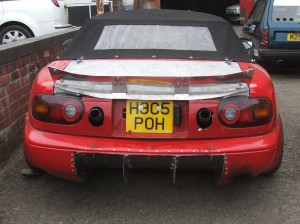 We’ve been building this hillclimb car for Practical Performance Car Magazine. The full details of the build will be available to read over the next few months. PPC mag have an event called the 999 challenge. The idea is to build the best MoT passable car you can for 999 quid and carry out a timed quarter mile and handling course. The fastest car wins. We decided to take the concept a step further and see if we could build a hill climb car for full competition still sticking to the 999 pound budget. The list of modifications is massive. We reduced the weight by about 20% which is hard going on a car that’s so light to start with. With all the weight stripped out we built a cage that not only keeps the driver safe but adds to the shells rigidity. The engine received a turbo and anti lag system including launch control and flat shift. It also features a hydrogen gas system for better combustion and a cold water spray for the intercooler. We carried out a few suspension and brake modifications and thoroughly set the cars geometry to give it perfect handling. The aerodynamics were last to be addressed and are controlled tightly by the regulations. We designed an aero package that other than the allowed rear spoiler didn’t change the cars silhouette. We achieved this with a flat underfloor, undercut splitter and a rear diffuser than uses a cut out into the rear bumper. The rear aero is fed by the exhaust gases between the spoiler and the diffuser which aid flow attachment. There’s still some fine tuning to be done but it should be an awesome package on a very tight budget
We’ve been building this hillclimb car for Practical Performance Car Magazine. The full details of the build will be available to read over the next few months. PPC mag have an event called the 999 challenge. The idea is to build the best MoT passable car you can for 999 quid and carry out a timed quarter mile and handling course. The fastest car wins. We decided to take the concept a step further and see if we could build a hill climb car for full competition still sticking to the 999 pound budget. The list of modifications is massive. We reduced the weight by about 20% which is hard going on a car that’s so light to start with. With all the weight stripped out we built a cage that not only keeps the driver safe but adds to the shells rigidity. The engine received a turbo and anti lag system including launch control and flat shift. It also features a hydrogen gas system for better combustion and a cold water spray for the intercooler. We carried out a few suspension and brake modifications and thoroughly set the cars geometry to give it perfect handling. The aerodynamics were last to be addressed and are controlled tightly by the regulations. We designed an aero package that other than the allowed rear spoiler didn’t change the cars silhouette. We achieved this with a flat underfloor, undercut splitter and a rear diffuser than uses a cut out into the rear bumper. The rear aero is fed by the exhaust gases between the spoiler and the diffuser which aid flow attachment. There’s still some fine tuning to be done but it should be an awesome package on a very tight budget
Boys Toys
Tuesday, November 29th, 2011This BMW is a track day regular but as the owners talent has grown he felt the need for more grip. We carried out a full geoetry check but as a lot of the car was standard we could do little more than adjust the tracking. The customer decided to start his upgrades with a set of camber adjustable top mounts. These allowed us to improve the geometry to give him more front end grip. Next on the list is a set of coilovers. One step at a time though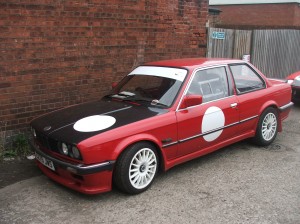
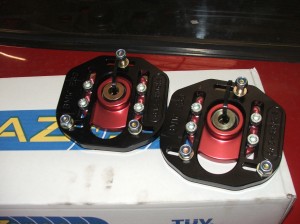
AA Sport
Wednesday, March 30th, 2011AA Silencers is going racing this year with sister company AA Sport. AA Sport deals with the performance side of the business including chassis tuning, car handling set ups and driver training. Company owner, Mark hammersley, is co-driving an ex BTCC Peugeot touring car. He shares the seat with Nigel Tongue who is campaigning his first season in this car. Mark will help with getting car and driver onto the pace and to the front of the grid. Pre season testing has gone well so far, time will tell when the lights go green at the first race!
Classic Celica
Monday, November 29th, 2010Another car for a feature in Practical Performance car. This time we joined the owner on a track day to gather some data on how his car handled. With some 380 BHP on tap the suspension was having to work pretty hard. Improvements were made on the day and using the data we’ve gathered there’s plenty more still to come. It’s lovely to see a real classic rally car like this still being used in anger on sprints and hill climbs
Snotty Skoda
Monday, November 29th, 2010I’m not being rude, Snotty is the nick name that’s been given to the Skoda, probably for obvious reasons. The cars owner has done a wonderful job of preparing the car for sprints and hill climbs. It has come to us for a Car Clinic feature in Practical Performance Car magazine. We carried out a full geomtry set up and made a few light modifications to the front suspension to help with grip. The car was tested at Mallory park and the owner now has all winter to carry out the suggested developments. If you come across this Skoda out on the road you’d better give him room, it’s a whole lot more car than it first appears. Or than the name suggests!
Four wheel alignment
Thursday, October 7th, 2010We’ve been working with Practical performance car magazine for some time now helping with their race efforts and carrying out a feature called ‘Car Clinic’. Here we take in cars either from road or track and improve their handling with some geometry set up. This involves measuring the various positions and angle of the wheels and suspension and adjusting them as required, it’s just a short leap on from tracking which a lot of people have done on their road cars. The latest car to pass through our hands is PPC’s Westfield XI. Measurements were taken for tracking, camber, castor, heights, wheelbase, track and axle offset . A few tweeks later and the car’s ready just in time for the last race of the 2010 season.

